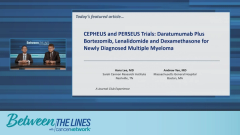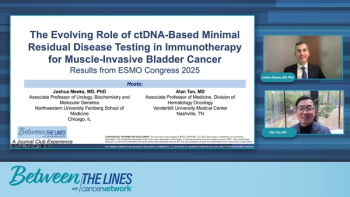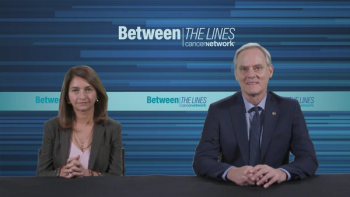
Treatment Overview of Transplant-Eligible Newly Diagnosed Multiple Myeloma
Panelists discuss the adoption of 4-drug regimens—including a CD38 monoclonal antibody—as the standard frontline therapy for patients with transplant-eligible multiple myeloma, emphasizing tailored modifications based on age and frailty, and evolving maintenance strategies that incorporate daratumumab to deepen and sustain responses post-transplant.
Episodes in this series

Recent advances have significantly shaped the treatment approach for patients with newly diagnosed transplant-eligible multiple myeloma. Current guidelines highlight the preference for 4-drug regimens, typically incorporating a CD38 monoclonal antibody such as daratumumab, combined with agents such as lenalidomide, bortezomib, and dexamethasone. This approach is now widely accepted as the foundation of therapy for these patients, offering deeper responses and improved outcomes compared with earlier 3-drug combinations. The addition of the monoclonal antibody has been a game changer, providing both enhanced efficacy and manageable safety profiles.
When considering patient-specific factors such as age and frailty, modifications to the regimen are common in clinical practice to optimize tolerability. For younger patients, often defined as those under 60, carfilzomib-based regimens may be favored due to their potent activity, although there is ongoing debate about the best proteasome inhibitor to use. For older patients or those with comorbidities, daratumumab combined with bortezomib, lenalidomide, and dexamethasone remains a preferred approach, with dose adjustments to reduce toxicity. Practical strategies such as weekly bortezomib dosing and early dexamethasone dose reduction help minimize adverse effects such as peripheral neuropathy and steroid-related complications.
Maintenance therapy after transplant continues to evolve, with lenalidomide monotherapy still considered a standard of care. However, emerging data support the inclusion of daratumumab in maintenance regimens to deepen and sustain responses, especially in patients who received CD38 antibody-based induction. The decision to intensify maintenance is often personalized, taking into account disease risk factors and patient tolerance. Overall, the current paradigm emphasizes a 4-drug induction regimen followed by maintenance tailored to prolong remission and improve quality of life for transplant-eligible patients.
Newsletter
Stay up to date on recent advances in the multidisciplinary approach to cancer.

















































































